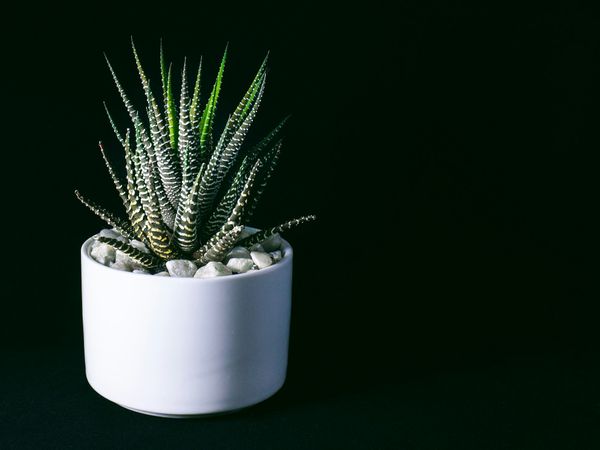Zebra Plant Care Guide
How to grow and care for Zebra Plant (Haworthia fasciata)
The Haworthia fasciata, commonly known as the Zebra Plant, is a charming succulent recognized for its striking appearance and easygoing nature. Characterized by its fleshy, pointed leaves adorned with horizontal white ridges, it makes a delightful addition to any indoor plant collection. As a South African native, this plant is well-suited for indoor environments where it can thrive with minimal effort, making it an ideal choice for both novice and experienced plant enthusiasts.

Disclosure: This content includes affiliate links, which means we may earn a commission if you click on a link and make a purchase. As an Amazon Associate, we earn from qualifying purchases. This comes at no extra cost to you and helps offset the cost of running Leafwise. Please read our disclaimer for more info.
Table of Contents
Care
Light
Haworthia fasciata thrives in bright light but not harsh, direct sunlight. They can tolerate direct morning sun, but intense afternoon rays may scorch their leaves. Indoors, they grow best near an east- or west-facing window. If outdoors, provide shade during the hottest parts of the day to prevent damage.
Watering
Water when the top inch of soil is dry, particularly during the spring and summer growing season. Avoid waterlogged conditions to prevent root rot. In fall and winter, reduce watering to just enough to keep the leaves firm and plump. Typically, watering every two to three weeks is sufficient, but adjust based on your environment.
Soil
Use a well-draining cactus or succulent mix to avoid excess moisture buildup. Incorporate perlite, coarse sand, or pumice to improve drainage and aeration. Ensure the pot has drainage holes to allow excess water to escape, minimizing the risk of root rot.
Temperature & Humidity
Maintain temperatures between 65°F-80°F (18°C-27°C). Although Haworthias can tolerate cooler conditions, prolonged exposure to temperatures below 50°F (10°C) can cause damage. Keep them away from cold drafts and sudden temperature fluctuations. They thrive in typical household humidity levels and do not require additional moisture.
Fertilization
Feed with a diluted liquid cactus fertilizer every 4-6 weeks during the spring and summer growing season. Follow label recommendations to avoid over-fertilization, which can damage the plant. Avoid fertilizing during fall and winter when growth naturally slows.
Maintenance
Pruning
Pruning is minimal but beneficial for maintaining a neat appearance. Remove any dead, yellowing, or shriveled leaves from the base of the plant to improve air circulation and overall plant health.
Repotting
Haworthias grow slowly and typically only need repotting every 2-3 years or when they outgrow their pot. Refresh the soil with a fresh, well-draining mix during repotting to promote healthy growth.
Propagation
The Zebra Plant is easy to propagate through offsets, also known as pups, which naturally grow at the base of mature plants.
Propagation Steps
- Remove the Offset: Gently separate the offset from the parent plant using a clean, sharp knife or twist it off carefully.
- Allow to Callous: Let the offset dry and callous for a day or two to prevent rot when planted.
- Plant in Soil: Place the calloused offset in a small pot with well-draining succulent soil.
- Water Sparingly: Lightly water the newly planted offset and place it in a warm, bright spot. Once roots develop and new growth appears, transition to regular care.
Common Issues
Pests
Common Pests: Mealybugs and spider mites can occasionally infest Zebra Plants.
- Symptoms: Sticky residue, webbing, or cotton-like clusters on leaves.
- Solution: Treat infestations by applying insecticidal soap or neem oil. Alternatively, wipe leaves with a damp, soapy cloth to remove pests. Mealybugs tend to hide in crevices, so inspect thoroughly. Rinse the plant with clean water after treatment and isolate it to prevent pest spread.
Root Rot
Cause: Overwatering or poorly draining soil.
- Symptoms: Yellowing or mushy leaves, foul-smelling soil, and soggy roots.
- Solution: Remove the plant from its pot, trim any rotting roots, and repot in fresh, well-draining soil. Allow the soil to dry completely before the next watering.
Yellowing Leaves
Cause: Overwatering or insufficient light.
- Symptoms: Leaves becoming soft, yellow, and eventually dropping off.
- Solution: Reduce watering frequency and ensure the plant receives adequate, bright light. Move it to a brighter location if necessary.
By following these care tips, your Haworthia fasciata will flourish and serve as a beautiful, low-maintenance addition to your home or office, showcasing its distinctive zebra-like striped leaves.
